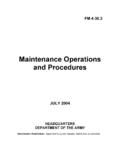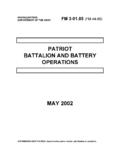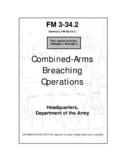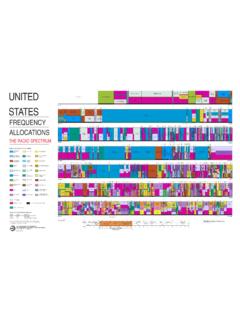Transcription of FM 2-01.3 MCRP 2-3A Intelligence Preparation of the ...
1 FM MCRP 2-3A. Intelligence Preparation of the battlefield / battlespace October 2009. DISTRIBUTION RESTRICTION: Distribution authorized to Government agencies only because it requires protection in accordance with AR 380-5 and as specified by DCS G-3 Message DTG 091913Z Mar 04. This determination was made on 19 July 2007. Contractor and other requests must be referred to ATTN: ATZS-CDI-D, Army Intelligence Center and Fort Huachuca, AZ 85613-7017, or via e-mail at DESTRUCTION NOTICE: Destroy by any method that must prevent disclosure of contents or reconstruction of the document. Headquarters Department of the Army Headquarters United States Marine Corps FOR OFFICIAL USE only . This publication is available at Army Knowledge Online ( ) and General Dennis J. Reimer Training and Doctrine Digital Library at ( ).
2 FM *MCRP 2-3A. Field Manual Headquarters No. Department of the Army Washington, DC. Marine Corps Reference Publication Headquarters No. 2-3A Marine Corps Combat Development Command Department of the Navy Headquarters United States Marine Corps Washington, DC. 15 October 2009. Intelligence Preparation of the battlefield / battlespace Contents Page PREFACE .. v SUMMARY OF CHANGES .. vii Chapter 1 IPB AND 1-1. Performing Intelligence Preparation of the battlefield / battlespace .. 1-1. IPB and the MDMP/MCPP .. 1-2. IPB and the Time-Constrained MDMP/MCPP .. 1-8. IPB and Troop-Leading Procedures .. 1-8. IPB and the Operational Environment/ battlespace Environment .. 1-9. The Operational Variables .. 1-9. DISTRIBUTION RESTRICTION: Distribution authorized to Government agencies only because it requires protection in accordance with AR 380-5 and as specified by DCS G-3 Message DTG 091913Z Mar 04.
3 This determination was made on 19 July 2007. Contractor and other requests must be referred to ATTN: ATZS-CDI-D, Army Intelligence Center and Fort Huachuca, AZ 85613-7017, or via e-mail at DESTRUCTION NOTICE: Destroy by any method that must prevent disclosure of contents or reconstruction of the document. *This publication supersedes FMFRP 3-23-2, 8 July 1994. Marine Corps PCN: 144 000141 00. i FOR OFFICIAL USE only . Contents Civil Considerations .. 1-10. 1-11. Chapter 2 STEP 1 DEFINE THE OPERATIONAL ENVIRONMENT/ battlespace . 2-1. Identify Significant Characteristics of the Environment .. 2-2. Identify the Limits of the Command's Area of Operations .. 2-2. Establish the Limits of the Area of Influence and the Area of Interest .. 2-3. Evaluate Existing Databases and Identify Intelligence Gaps.
4 2-4. Initiate Collection of Information Required to Complete IPB .. 2-5. Chapter 3 STEP 2 DESCRIBE ENVIRONMENTAL EFFECTS ON OPERATIONS/. DESCRIBE THE battlespace EFFECTS .. 3-1. Analyze the Environment .. 3-2. Describe the Environmental Effects on Operations and Threat and Friendly Courses of Action/Describe the battlespace Effects on Operations and Adversary and Friendly Capabilities and Courses of Action .. 3-20. Chapter 4 STEP 3 EVALUATE THE THREAT/ADVERSARY .. 4-1. The Threat/Adversary .. 4-2. Update or Create Threat/Adversary Models .. 4-4. Identify Threat/Adversary Capabilities .. 4-7. Chapter 5 STEP 4 DETERMINE THREAT/ADVERSARY COURSES OF ACTION .. 5-1. Identify the Threat's/Adversary's Likely Objectives and Desired End State .. 5-2. Identify the Full Set of Courses of Action Available to the Threat/Adversary.
5 5-2. Evaluate and Prioritize Each Course of Action .. 5-3. Develop Each Course of Action .. 5-4. Identify Initial ISR 5-8. Chapter 6 IPB FOR OFFENSIVE AND DEFENSIVE OPERATIONS .. 6-1. Offensive Operations .. 6-1. Defensive Operations .. 6-3. Chapter 7 IPB FOR STABILITY OPERATIONS OR CIVIL SUPPORT 7-1. Stability Operations Overview .. 7-1. Civil Support Operations Overview .. 7-1. IPB Considerations for Stability Operations or Civil Support Operations .. 7-2. Appendix A Intelligence SUPPORT TO THE TARGETING PROCESS .. A-1. Appendix B OPERATIONAL THEMES: IPB CONSIDERATIONS USING SELECTED. EXAMPLES OF MILITARY OPERATIONS .. B-1. Appendix C COUNTERINSURGENCIES AND IPB .. C-1. Appendix D GEOSPATIAL- Intelligence SUPPORT TO IPB .. D-1. GLOSSARY .. Glossary-1. References-1.
6 INDEX .. Index-1. ii fm 2 -3A 15 October 2009. FOR OFFICIAL USE only . Contents Figures Figure 1-1. The military decisionmaking process/Marine Corps planning process .. 1-3. Figure 1-2. Sample civil considerations (ASCOPE) .. 1-11. Figure 2-1. Define the operational environment/ battlespace environment substeps .. 2-1. Figure 2-2. Contiguous, noncontiguous, and unassigned areas .. 2-3. Figure 2-3. Spatial relationships (AO, area of influence, and AOI) .. 2-5. Figure 3-1. Describe environmental effects on operations/Describe the battlespace effects substeps .. 3-1. Figure 3-2. Example of observation and visual dead space .. 3-4. Figure 3-3. Intervisibility line .. 3-5. Figure 3-4. Concentric ring technique .. 3-8. Figure 3-5. Belt technique .. 3-9. Figure 3-6. Avenue-in-depth technique.
7 3-9. Figure 3-7. Box technique .. 3-10. Figure 4-1. Evaluate the threat/adversary substeps .. 4-1. Figure 4-2. Threat/Adversary template using an urban environment .. 4-6. Figure 5-1. Determine threat/adversary courses of action substeps .. 5-1. Figure 5-2. Event template .. 5-9. Figure 5-3. Event matrix .. 5-10. Figure B-1. The spectrum of conflict and operational themes ..B-2. Tables Table B-1. Examples of joint military operations conducted within operational themes ..B-2. Table C-1. Mao Zedong's three phases of insurgency .. C-4. 15 October 2009 fm 2 -3A iii FOR OFFICIAL USE only . This page intentionally left blank. Preface This manual is a dual-designated Army and Marine Corps manual. It describes the fundamentals of Intelligence Preparation of the battlefield / Intelligence Preparation of the battlespace (IPB).
8 It describes IPB, its use in directing the Intelligence effort, and its role in driving the staff's planning for military operations. In doctrinal publications, the normal convention for identifying terms is through the use of italics. Since this is a dual designated Army and Marine Corps manual, the following protocol is used to distinguish proponency (authority) for information and terms: Terms and phrasing in italics Marine Corps. Terms and definitions in bold Terms for which FM is the proponent publication. Terms in bold and definitions in plain text Joint terms and Army terms a with proponent publication other than FM The proponent publication (in italics) follows the definition. This manual conforms to the overarching doctrinal concepts presented in Army doctrine (FM 3-0 and fm 2 -0).
9 And Marine Corps doctrine (MCWP 3-1 and MCWP 2-1). This manual is intended to provide guidance for all commanders, staffs, trainers, and military Intelligence personnel at all echelons. It provides doctrinal guidance for the use of IPB in directing the Intelligence effort and its role in supporting the commander and staff. It also serves as a reference for personnel who are developing doctrine; tactics, techniques, and procedures (TTP); and institutional and unit training for military operations. It is also intended for commanders and staffs of joint and multinational commands, Navy forces, Air Force forces, and the military forces of multinational partners. This manual keeps the title Intelligence Preparation of the battlefield to describe the process of analyzing the operational environment/ battlespace environment and the options it presents to friendly and threat/adversary forces.
10 Emerging joint doctrine uses the term Intelligence Preparation of the operational environment.. However, the joint doctrine is not approved at this time, so the Army will utilize IPB. Future revisions will incorporate the joint title for the process. The Marine Corps entitles the process Intelligence Preparation of the battlespace in order to clearly distinguish the Intelligence Preparation process of the joint force commander from that of the component commander. Throughout the text, the use of the term Intelligence Preparation of the battlefield / battlespace refers to both the Army's process and the Marine Corps' process. In Army doctrine the term battlespace is replaced by, operational environment, area of operations, or area of influence, as appropriate. This manual applies to the Active Army and Marine Corps, the Army National Guard/Army National Guard of the United States, Army Reserve, and the Marine Corps Reserve unless otherwise specified.














